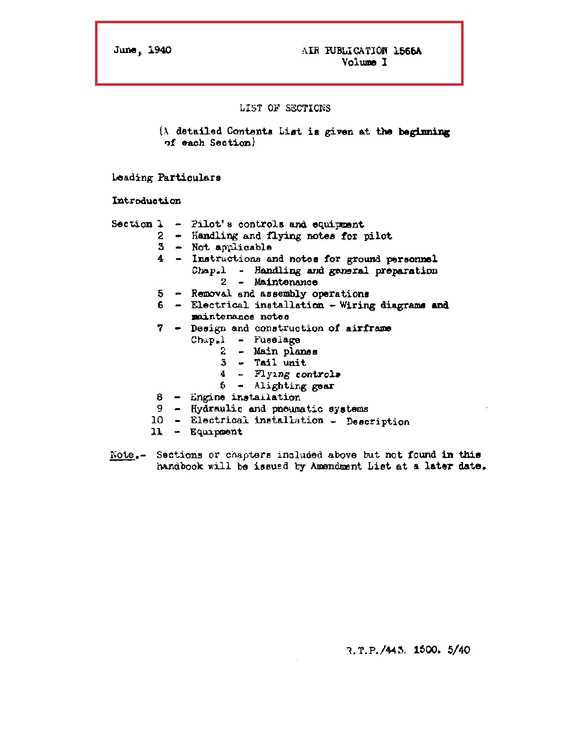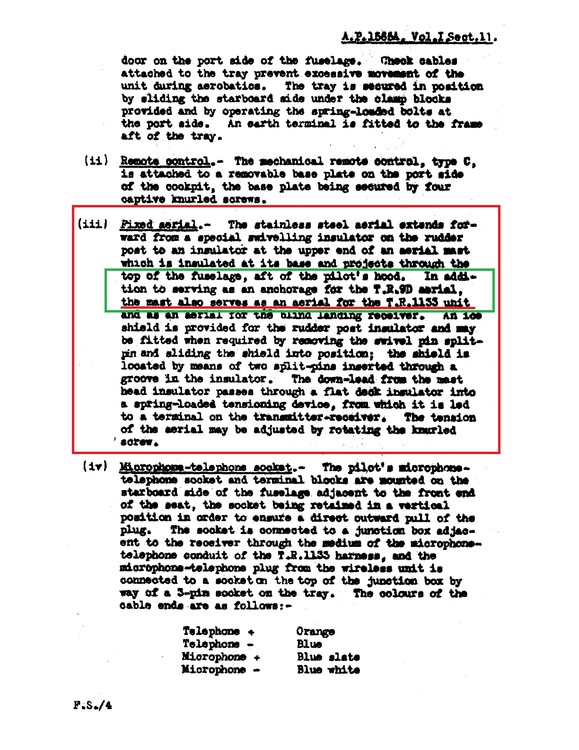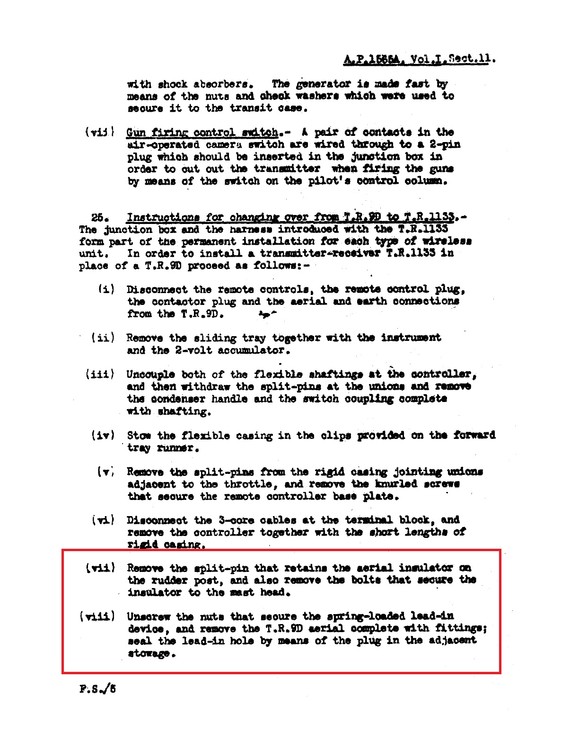-
Posts
709 -
Joined
-
Last visited
-
Days Won
1
Content Type
Profiles
Forums
Events
Everything posted by Friedrich-4B
-
In addition to this, the universal air intake could be fitted with a denser "Tropical" air filter, that reduced ram pressure cf the temperate version; as a result, the top speeds suffered; BS310 was tested with both the temperate and tropical variants in late 1942: (NB: the Vokes Universal air intake system was standardized on the Mk VIII and introduced to the IX in late-1943-early 44.)
-
All rather meaningless, because the RM-9SM prototype was dropped in favour of the Merlin 66 because of the latter's greater efficiency.
-
Apparently the new design of air intake wasn't fitted to either MA648 or the serial production L.F Mk. IXs, nor was BS543 a fully operational L.F. Mk. IX, while Kurfurst's claim that BS543 had a rich mixture was definitely confirmed (based on Kurfurst's speculation about how the power curve looks, and nothing else.) So when will Kurfurst show us these later tests and results? To help, here is the list of tests carried out on the Mk IX, from Morgan and Shacklady: Clearly more misinformation by Kurfurst; the trials carried out by BS543 or BS551 were not "repeated later"...the closest was BS310 by Vickers-Armstrong in December '42. ;) No doubt Kurfurst has the results of his "previous trials" of the S.U., seeing as he also knows of other tests conducted using BS543 & 551? As it was, the increases in FTH by MA648 were For interest, here's an article on how the Bendix injection carb worked, and the engines it was used on. back to the report, for what it's worth: Wow! An average increase of 3 mph because of a higher FTH (ie: about .75% difference)! (Note: this was mainly because JL165's performance was some 16 mph below-par, as is noted here.). Anyway, as has been pointed out several times, but completely ignored by Kurfurst, Yo-Yo did not just model the Spitfire IX's performance figures on a few reports off the internet - they are indicative of the results he got from independent modelling and testing. Hopefully, once DCS's Spitfire IX does come out, Kurfurst will actually buy the product and provide us with a professional, well argued summary of exactly how the Spitfire should fly and perform, preferably using the same modelling techniques and the same information that Yo-Yo uses. This was the same intake that Kurfurst adamantly claimed didn't exist as a production item, even after 16 years of "research". :smilewink:
-
:doh: 16 years of so-called research and Kurfurst still doesn't know what air filters were fitted to L.F Mk. IXs? Note what MA648's report says: The "standard" air intake was this one: as compared with the Vokes universal, as fitted to MA648 and production Spitfire L.F. IXs: Kurfurst is confusing two reports, that of BS310 w/Merlin 70 is here http://www.spitfireperformance.com/bs310.html The report mentioning a rich mixture is http://www.spitfireperformance.com/bs543.html and it reads as follows: BS551, NOT BS543, was suffering from a fuel-rich mixture, that lowered the service ceiling and reduced the rate of climb. Nowhere, in any of the reports, is BS543 described as operating with a fuel-rich mixture. BS534's career: an ex-Spitfire VC converted to a Mk IX w/Merlin at R-R Hucknall, then to an L.F Mk IX: BS543 IX 3534 R-R M61 FF 22-10-42 R-RH Cv IX M61 23-10-42 AFDU Duxford 8-11-42 AAEE 13-12-42 M66 (RM10SM) install comparison trials with BS534 and BS551 see BS534 for details CRD VA 22-2-43 403S 9-6-43 611S 10-6-43 AST 19-6-43 mods 485S 'OU-F' 6-7-43 Missing from sweep 22-8-43
-
Actually, the so-called "experimental" air intake was the Vokes "universal system, as fitted on the vast majority of the L.F Mk. IXs, as well as to Mk VIIIs and IXs.
-
For interest, this is how the A&AEE achieved their test results:
-
Over Western Europe in 2 TAF, the L.F. IX's primary role was that of tactical fighter-bomber, although it was also being used as an air-superiority fighter. Going back to Yo-Yo's original post: So forum members can evaluate the cited reports for themselves, and in context, here are the figures for BS543, MA648 & etc while here is the report for BS543, compared with BS551 powered by a Merlin 70. As already noted: Yo-Yo has made it clear that his research covered far more than just the information shown in the reports on BS543 and MA648: The propeller BS543 used did very little to influence the performance because, as shown in this original document the so-called experimental ("original") duralumin Rotol 10'9" diam. XH.54D RM-SS, produced inferior climb performance and conferred no appreciable difference in speed cf the "production" propeller, Mark R3/4F5/3, or the Hydulignum unit, XH54H/RM/SS. As it is, DCS is modelling the Jablo (compressed wood) bladed Rotol type R.5/4F5/3 or similar, that was also a production unit.
-
Thanks for the clarification SiTh: as with the other FMs, and with access to properly restored Spitfire IXs, Yo-Yo has access to far more data than can be found on the internet. :thumbup:
-
Looking good: Thanks Yo-Yo :thumbup:
-

How similar is the K4 to the G10 or G14
Friedrich-4B replied to TheJay15's topic in DCS: Bf 109 K-4 Kurfürst
Essentially, it makes no difference what P-51D block number ED has modeled because the P-51D's performance and handling was pretty much the same, regardless of the block number. Major aerodynamic changes were made to the tail unit (all metal elevators, decreased incidence) and rudder (installation of rudder reverse boost tab), but these were modifications that could be retrofitted to all Ds. -

DCS: Spitfire Mk LF IXc Discussion
Friedrich-4B replied to Yo-Yo's topic in DCS: Spitfire L.F. Mk. IX
Here's another encouraging image; in this case Brendan Deere's restored IX, in the 1943 vintage colours and markings of Wingco Alan "Al" Deere. -

[RESOLVED]P51D's speed underperformance
Friedrich-4B replied to GrapeJam's topic in Bugs and Problems
This is a transcript of the Wright Field tests; http://www.wwiiaircraftperformance.org/mustang/p-51d-na-46-130.html the chart: http://www.wwiiaircraftperformance.org/mustang/na-46-130-chart.jpg -
http://www.flyingheritage.com/TemplatePlane.aspx?contentId=30 From what I can find, the victory symbols picked out in red were air-to-air, while the plain swastikas were for kills scored while ground strafing: the USAAF recognised that ground strafing, particularly of heavily defended targets such as airfields, was dangerous enough that aircraft destroyed on the ground could be categorised as kills. Down to Earth: Strafing Aces of the Eighth Air Force. Some further material related to the USAAF's tactical operations
-

DCS: Spitfire Mk LF IXc Discussion
Friedrich-4B replied to Yo-Yo's topic in DCS: Spitfire L.F. Mk. IX
I have no objection to this idea...as long as you're prepared to do all the flight testing. :smilewink: -
For entertainment, here's a rundown of the production quality problems experienced at the Mtt Regensburg plant (from A Nest of Eagles: Messerschmitt Production and Flight-Testing at Regensburg 1936-1945: So, yes, in real life there were major production control problems that impacted directly on 109K-4s through to the end of production in late April 1945; the overwhelming majority of K-4s were built at Regensburg and associated plants, while a handful were built at Erla. For practical purposes, Ed assumes that the build quality of the aircraft it models is uniformly good.
-

DCS: Spitfire Mk LF IXc Discussion
Friedrich-4B replied to Yo-Yo's topic in DCS: Spitfire L.F. Mk. IX
This "issue" about the clipped wings has already been canvassed in this thread and is based on reports and comments that didn't relate to the L.F. Mk IX, except in a most general sense. The belief that pilots didn't like the clipped wings, for example, is based on a small survey of Mk V pilots in which 5 out of 6 respondents considered the modification to be an improvement, while apparently those from an unspecified squadron didn't. The rest of the report, including the conclusions, is missing, so no real help there. As it is, the majority of 2 TAF's Spitfire L.F Mk IXs retained the normal wingtips; the main "clipped" variant in 2 TAF service was the L.F Mk. XVI, the majority of which were built with clipped wings. Later in the war, F. Mk. XIVs were also using clipped wings. AFAIK there were no official reports on the L.F Mk. IX's flight qualities and performance with clipped wings, so the best available information is based on Mk V tests: The reason for the "clipped. cropped, clapped" legend was because many of the Spitfire Vbs that were modified to use the Merlin 45M or 55M, together with the clipped wingtips, were elderly airframes that had seen better days: one of them, for example, was W3834. Built in September 1941, it had already served on five squadrons, before being allocated to 401(Canadian) Sqn in July 1943. "Cropped" referred to the cropped, low altitude rated supercharger impeller - "clipped" and "clapped" for obvious reasons. None of this has much to do with the 1944 vintage L.F. IX that was a new-build airframe, using the Merlin 66 with a 2-stage, 2-speed supercharger that used different gear ratios, rather than a cropped impeller, to achieve its medium to low altitude rating. Back to Ed's Spitfire L.F. Mk. IX...for mind, getting the basics right is the most important part; variations and options can then be added. Anyway, VEAO is modelling the clipped wing XIV, so we get the best of both variations. -

DCS: Spitfire Mk LF IXc Discussion
Friedrich-4B replied to Yo-Yo's topic in DCS: Spitfire L.F. Mk. IX
Just for interest, here's a 1940s vintage, Rolls-Royce film about manufacturing the Merlin: [ame] [/ame] -

DCS: Spitfire Mk LF IXc Discussion
Friedrich-4B replied to Yo-Yo's topic in DCS: Spitfire L.F. Mk. IX
*Cough!* Surely the B of B theme is more suited to the Spitfire I? (fast exit, stage left before :tomato:) -

DCS: Spitfire Mk LF IXc Discussion
Friedrich-4B replied to Yo-Yo's topic in DCS: Spitfire L.F. Mk. IX
That's a bit harsh; this Edmond Hall and His Quartet recording is from July 1944 and embodies a similar slightly jangly but lively optimism to the theme for the Spitfire IX. :smilewink: [ame] [/ame] (I don't know if Ed's budget stretches to hiring a jazz quartet for their soundtrack) -

DCS: Spitfire Mk LF IXc Discussion
Friedrich-4B replied to Yo-Yo's topic in DCS: Spitfire L.F. Mk. IX
Better still, these manuals are free, albeit with a small membership fee: http://www.avialogs.com/en/aircraft/avialogs/aircraft-manuals-and-documents.html Using the term flight manuals on cd produces (this outfit also sells via EBay): http://www.flight-manuals.com/spitfire.html while A.P. 1590 S&U Vol 1 can be found here: http://www.flight-manuals.com/ap1590psu-vol1.html and in Avialogs. Be aware, however that the pages on this Merlin 66 67 70 71 76 77 85 manual have been scrambled - when I have some spare time I'm going to get them back into their right order. -

DCS: Spitfire Mk LF IXc Discussion
Friedrich-4B replied to Yo-Yo's topic in DCS: Spitfire L.F. Mk. IX
The headrest probably won't be a problem if your head isn't being subjected to positive and negative g while you're trying to look to the rear and/or down during combat...mind you, the 'rest was probably missed by pilots who bounced their heads off the armour plate. :wacko: Anyway, here's a list of Spitfire modifications and the dates on which they were introduced: Mods 385, 662 and 801 describe the change-over to the T.R.1143, deletion of the headrest and introduction of the IFF Mk III with rod aerial. (Morgan & Shacklady, page 171). -

DCS: Spitfire Mk LF IXc Discussion
Friedrich-4B replied to Yo-Yo's topic in DCS: Spitfire L.F. Mk. IX
+1 In 1940, the HF T.R.9.D was being replaced by the VHF T.R.1133: attached are pages from A.P. 1565A, Spitfire I Merlin II & III Engine (June 1940). Note that the aerial mast was the aerial for the T.R. 1133 The problem with the T.R.9D in 1940 was that it was limited to one or two frequencies, plus its reception was often so bad that pilots couldn't hear air to air or ground to air transmissions properly (modern HF radios don't suffer from the limitations of the T.R.9 series) - the T.R 1133's, which were replaced by 1943 by the improved T.R.1143, operated over a wider range of frequencies and the reception was much clearer. This 1942 photo of an early production Spitfire F. Mk. IX of 611 Sqn is representative. In addition, a typical 1944 vintage L.F. Mk IX had a rod IFF antenna under the outer starboard wing - also note, in both photos there's no longer a headrest, as mentioned by Azref. AFAIK it was removed because it hindered the pilot's ability to look to the rear. -
For those who are interested (and slightly OT) two Dunkirk-era Spitfires have been recovered and restored over the last few years: N3200 is the most recent [NB: some generalizations during the commentary].
-

DCS: Me 262 Discussion (Development on hold currently)
Friedrich-4B replied to NineLine's topic in Western Europe 1944-1945
And, to keep the ball rolling from 5tuka's post, attached is the complementary article on the Me 262's airframe, plus an article on Anselm Franz, designer of the Jumo 004 -

DCS: Me 262 Discussion (Development on hold currently)
Friedrich-4B replied to NineLine's topic in Western Europe 1944-1945
Here is the maintenance manual for the General Electric CJ610 turbojet, cleverly disguised as a Jumo 004 B-1 Handbuch.






